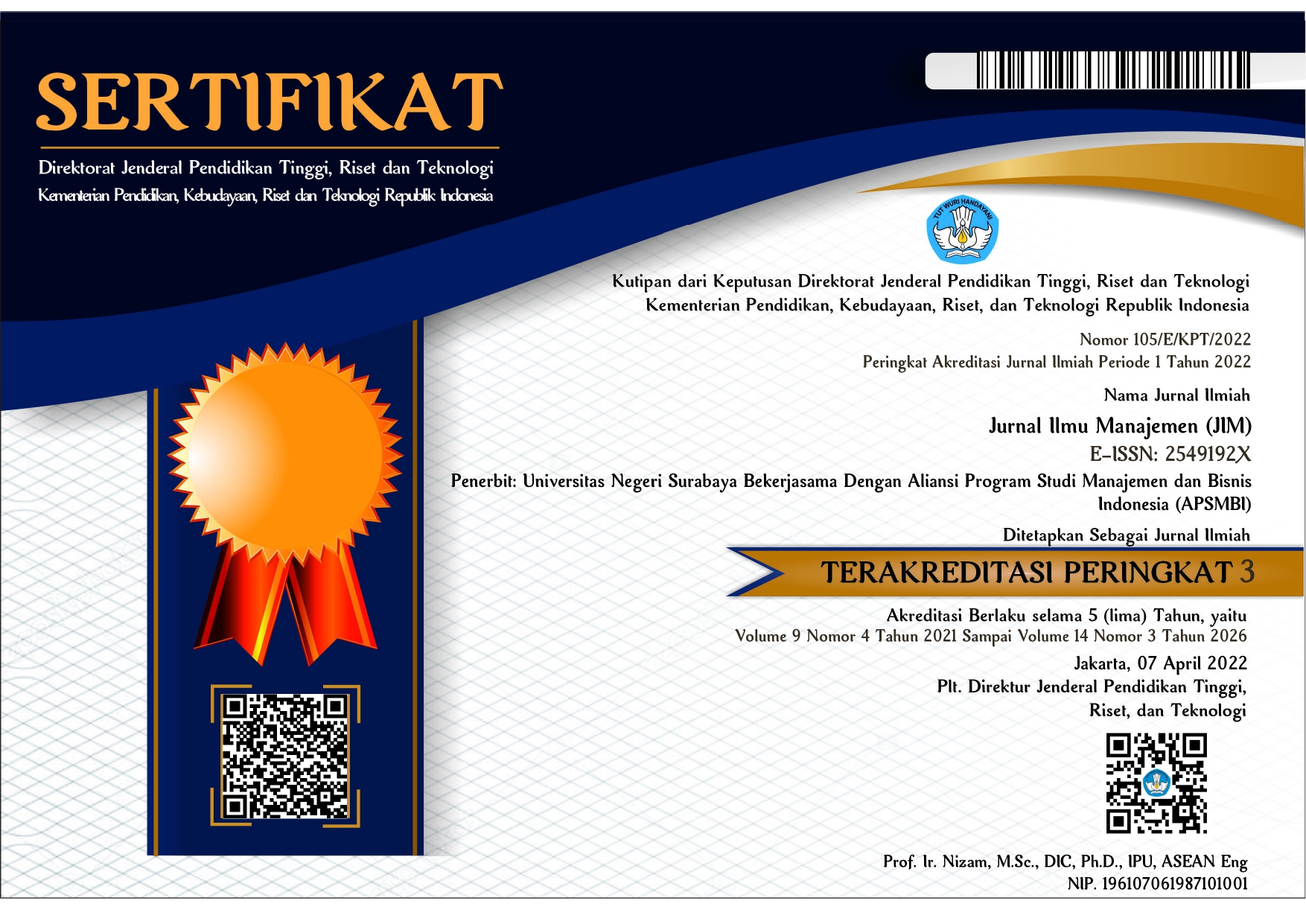Pengaruh Value Congruity dan Psychological Ownership terhadap Loyalty: Peran Consumer Engagement sebagai Variabel Mediasi
DOI:
https://doi.org/10.26740/jim.v10n2.p619-633Keywords:
consumer engagement, loyalty, music industry, psychological ownership, value congruityAbstract
There are so many researches talks about marketing, especially about loyalty. But only a view of them raises the topic of loyalty in the music industry so that many things can be disseminated in the music industry, including musicians. Flexibility in listening to music through digital music platforms is among many ways to spread loyalty among listeners towards musicians. One of the musicians who get the loyalty of their music listeners in a large number and relatively short time is The Panturas. This study discusses things that might affect the occurrence of those phenomena using quantitative methods, especially the causal relationship of value congruity and psychological ownership to the loyalty of The Panturas' listeners with consumer engagement on their official Twitter account as a mediating variable. The sample collection technique used is non-probability sampling with a total sample of 200 respondents from The Panturas' music listeners. All the respondents were filtered through screening questions where they must meet the criteria as listeners of The Panturas's music who follow and have interacted in the form of comments, quote tweets, direct messages, or mentions on The Panturas' official Twitter account. This study uses data analysis techniques named path analysis which contains hypothesis testing, model analysis, and Sobel test to determine the role of mediating variable. The results of this study indicate that all hypotheses are accepted. Still, the mediating variable studied, consumer engagement, doesn't play its role as a mediator of the relationship between value congruity and psychological ownership with loyalty.
References
Bicaramusik.id. (2020). The Panturas. (http://bicaramusik.id/profil/t/the-panturas/, diakses pada 23 Juni 2022).
Dewatara, G. W., & Agustin, S. M. (2019). Pemasaran musik pada era digital digitalisasi industri musik dalam industri 4.0 di Indonesia. WACANA Jurnal Ilmiah Ilmu Komunikasi, 18(1).
Ghozali, I. (2016). Aplikasi Analisis Multivariete Dengan Program IBM SPSS 23 (8th ed.). Badan Penerbit Universitas Diponegoro.
Hair, J. F., Black, W. C., Babin, B. J., & Anderson, R. E. (2010). Multivariate Data Analysis (7th ed.). Prentice Hall International.
Islam, J. U., Rahman, Z., & Hollebeek, L. D. (2018). Internet Research Consumer engagement in online brand communities: A solicitation of congruity theory Article information. Emerald Insight, 28(1).
Katadata.co.id. (2020). Pangsa pasar pelanggan berbayar layanan musik digital (kuartal II - 2020). (https://databoks.katadata.co.id/datapublishembed/118395/spotify-penguasa-pasar-layanan-musik-digital-berbayar, diakses pada 25 November 2021).
Kaur, H., Paruthi, M., Islam, J. U., & Hollebeek, L. D. (2020). The role of brand community identification and reward on consumer brand engagement and brand loyalty in virtual brand communities. Telematics and Informatics, 46, 101321. https://doi.org/10.1016/j.tele.2019.101321
Kompas. (2020). Perbedaan kemandirian laki-laki dan perempuan. (https://www.kompas.com/skola/read/2020/03/03/090000169/perbedaan-kemandirian-laki-laki-dan-perempuan?page=all&jxconn=1*1nrvxqk*other_jxampid*cDlveGlGeEZGTnllY3h5LUR2b2JiNExpSTh5WDRvQjRIWEVHdkg0LWM2d202VDhXdUhmWF9ULXlLUzFQc3g1dg..#page2, diakses pada 1 Februari 2022).
Kompas. (2021). Mengenal Apa Itu Generasi Baby Boomers, X, Y, Z, Millenials, dan Alpha. (https://www.kompas.com/tren/read/2021/12/26/170000565/mengenal-apa-itu-generasi-baby-boomers-x-y-z-millenials-dan-alpha?page=all#page2, diakses pada 1 Februari 2022).
Kotler, P., & Keller, K. L. (2009). Manajemen Pemasaran (A. Maulana & W. Hardani (eds.); 13th ed.). Erlangga.
Kumparan. (2021). The Panturas Bicara Perkembangan Genre Surf Rock di Indonesia. (https://kumparan.com/millennial/the-panturas-bicara-perkembangan-genre-surf-rock-di-indonesia-1v9l19jN8Pi, diakses pada 23 Januari 2022).
Pikiranrakyat.com. (2020). The Panturas, Biduk Pembaru Musik Rock. (https://www.pikiran-rakyat.com/entertainment/pr-01333515/fixriaupesisir.pikiran-rakyat.com?page=5, diakses pada 23 Januari 2022).
Downloads
Published
How to Cite
Issue
Section
License

This work is licensed under a Creative Commons Attribution-NonCommercial 4.0 International License.
 Abstract views: 648
,
Abstract views: 648
, PDF Downloads: 538
PDF Downloads: 538










